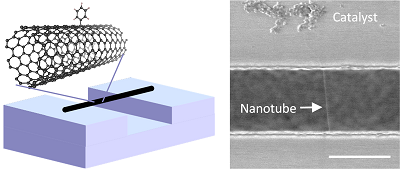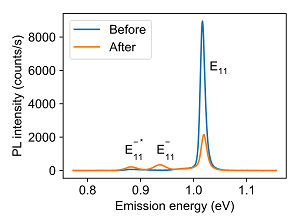Research:Formation of organic color centers in air-suspended carbon nanotubes using vapor-phase reaction
The use of quantum light attracts attention as a technology that goes beyond conventional information processing and communication. Carbon nanotubes have great potential as a quantum light source because they can generate single photons at room temperature in the telecom wavelength range. Such single photon generation has been achieved by intentionally introducing quantum defects based on organic color centers through chemical modification. Air-suspended carbon nanotubes immediately after synthesis are expected to be used as a quantum light source because their photoluminescence (PL) quantum yield is several times higher than that of solution-dispersed nanotubes, which are commonly used. Existing methods, however, are limited to a solution process which is incompatible with air-suspended carbon nanotubes.

We here demonstrate a method for functionalization of air-suspended carbon nanotubes by a vapor-phase chemical reaction method using iodobenzene vapor. The introduction of quantum defects can be verified by comparing emission spectra of the same nanotubes before and after the reaction. Before the reaction, only the E11 peak is observed whereas after the reaction, E11- and E11-* peaks are observed, indicating that these peaks originate from the quantum defects. We also observe that intensity of the E11 peak decreases after the reaction.

The quenching of the E11 emission can be explained by the diffusion equation, which takes into account that excitons generated by photoexcitation diffuse and quench at introduced defects. By comparing the simulation of the PL intensity using this physical model with the experimental results, the defect density is estimated and plotted as a function of the diameter shown in a figure below. We find that tubes with smaller diameter shows higher reactivity and denser defects.

In summary, we have demonstrated that quantum defects can be introduced into air-suspended carbon nanotubes using a vapor-phase chemical reaction method. The vapor-phase reaction should allow for precise control of the number of reacting molecules, and the technique will be able to introduce quantum defects at the single-molecule level. This technique is also important because it enables the introduction of very low-density defects down to 1-2 defects per micrometer of nanotube length. If the reaction conditions can be further optimized to introduce only one quantum defect per nanotube, the technique will lead to telecom single photon sources with improved performance.
To learn more about this work, please refer to
Formation of organic color centers in air-suspended carbon nanotubes using vapor-phase reaction
Nature Commun.
13, 2814 (2022).
![]()
RIKEN Research Highlight: "A cleaner, better way to produce single-photon emitters"